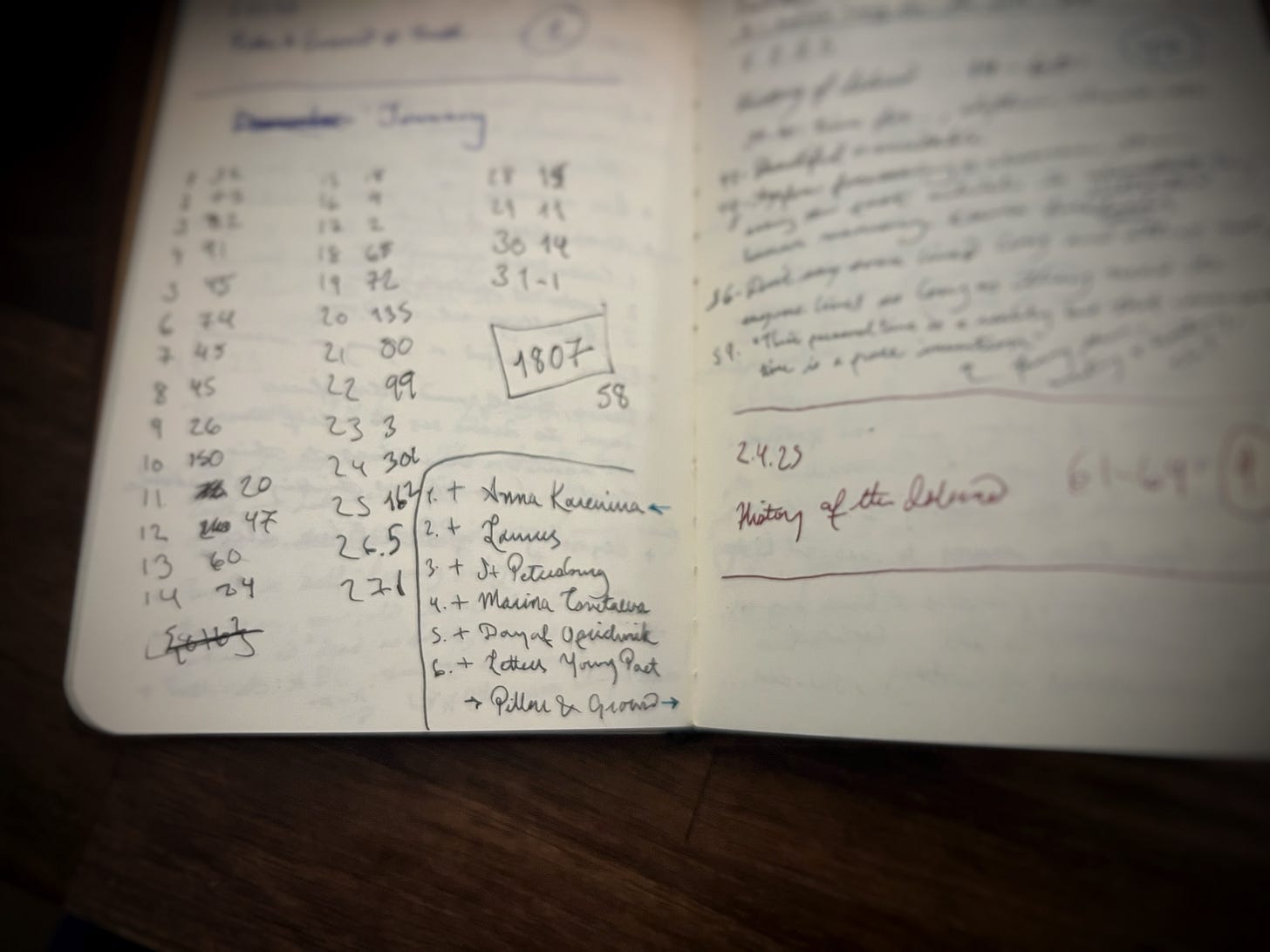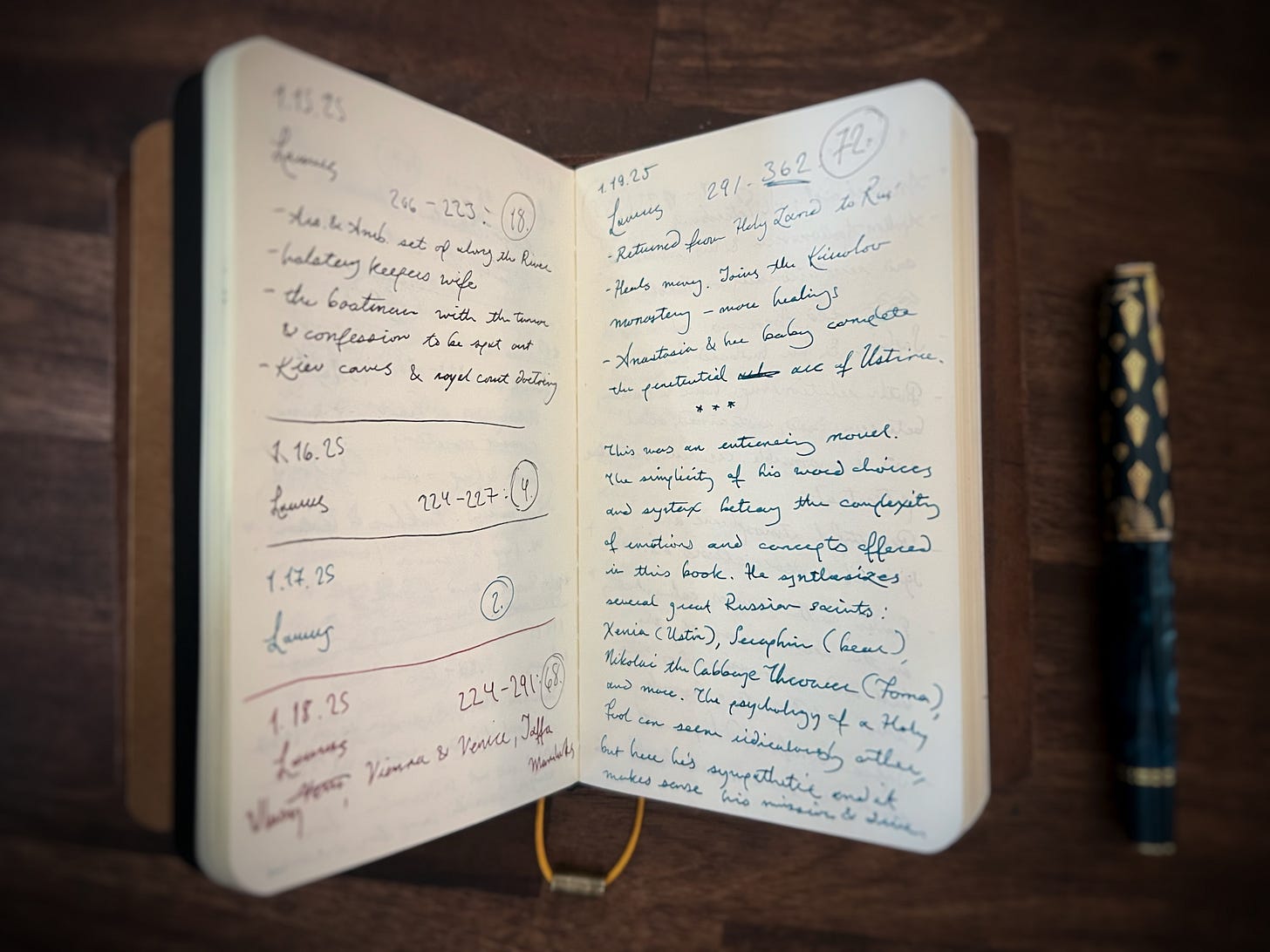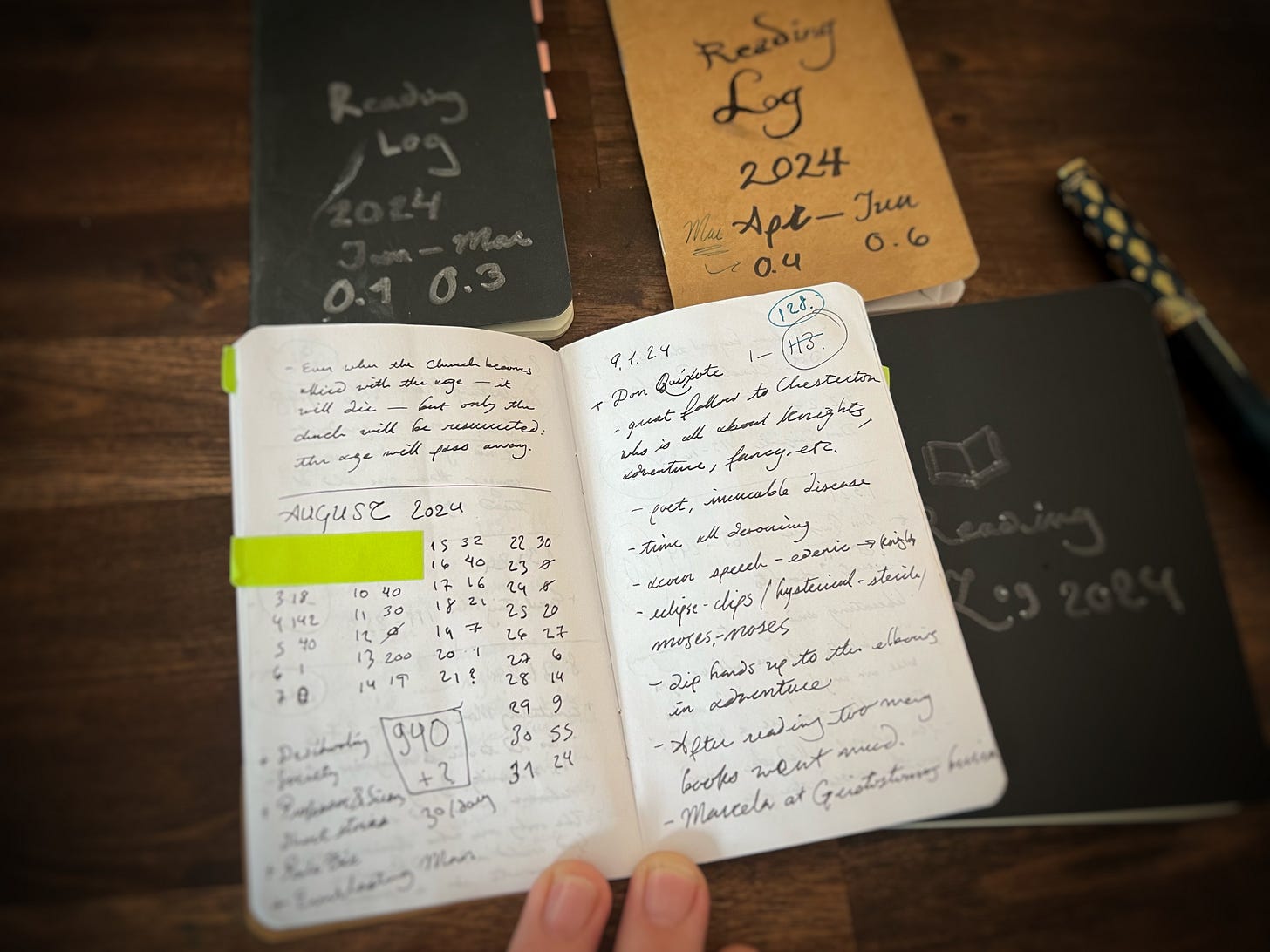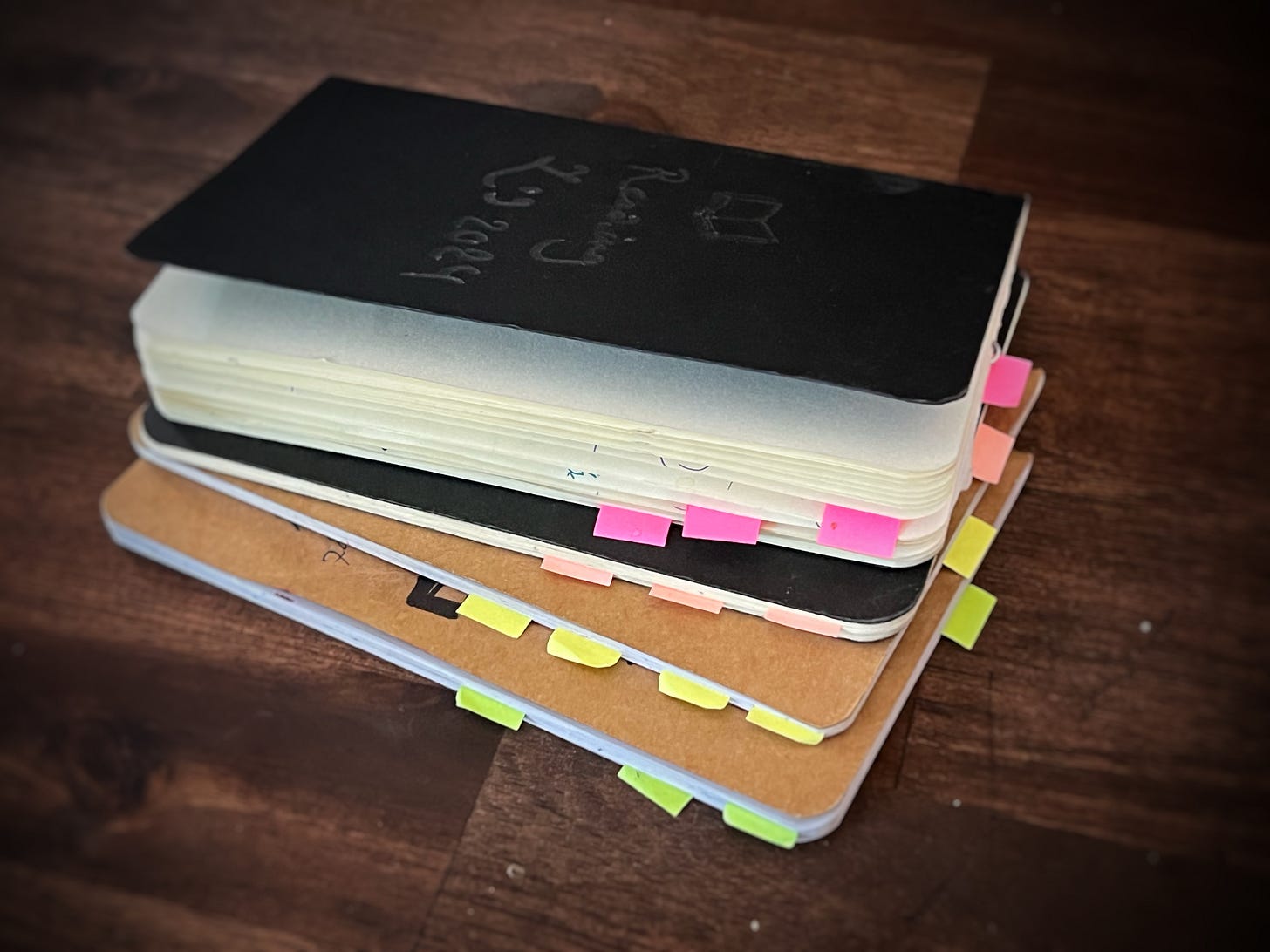Reviewing Reading Logs: Armchair Method
How to actually review the notes you take—and relive your life in the process.
The one habit that has most enriched my reading life has been keeping a daily Reading Log. A reading session is never complete without jotting down the books and pages I read that day—occasionally with key words or other notes tossed in as well. In another post, I mention how I use my logs to begin my reflection on books. Paging back through entries, I often revisit interesting ideas from philosophers or relive remarkable moments from novels. This is much better than scrolling.
More than merely being objective collections of facts, these are records of how I spent many devoted hours of my year—of my life. Thus, out of all my planners or journals, these are probably my most treasured notebooks.
In this post, I cover the process of regularly reviewing your Reading Logs. While daily logging is a helpful capture method, capturing without reviewing is a lot of wasted energy. Likewise, when we want to revisit our notes, we should structure things in a way to help our future selves track down exactly what they’re look for. Finally, we need to keep this organization lightweight and stress-free. Here’s how I do all that.
Breaking a Year into Four Books
Rather than having one large commonplace book, I like to break up my reading across four small pocket notebooks. If a book is too big, I just won’t lug it around. If I don’t lug it around and keep it near me, I won’t keep it up to date. Instead, these smaller pocket books are almost always within arms reach. Wrapped in a leather cover, one Reading Log and one Catch-All are always nearby, either tucked in my pocket or sitting on a table next to me. (Again, see previous post on that setup.)
For whatever reason, my handwriting is always at its worst when it comes to writing their titles. But no matter. They’re rugged little books that get beat up anyway.
In addition to portability, these smaller books help me break up my reading notes into chronologically meaningful chunks. Again, rather than abstracting my notes out of time and placing them into some eternal commonplace book, I like leaving them in the order they were recorded. Then, reviewing my notes becomes reliving my life.
Since these books contain a year of reading, it makes sense to break them up as we break up the year. As much as I’d love to break them up according to something more poetic like the seasons, I just fall back into my old, corporate habit of annual quarters:
Q1 = Jan, Feb, Mar
Q2 = Apr, May, Jun
Q3 = Jul, Aug, Sep
Q4 = Oct, Nov, Dec
Thankfully, these pocket books accommodate three months fairly comfortably. Each notebook contains 60 pages and, again, most of my entries are very short: date, title, pages, and maybe few keywords. Most pages contain three to five days. Occasionally, a reading session will break the mould and my notes will spill across a page or two. Stumbling upon these remarkable days during a review is a real treat.
If I find I’m taking a lot of notes for a book, I will usually write those out on some index cards or notepad slips instead. When I’m done with the book, I’ll fasten them into the Reading Log with a paper clip on the page with that book’s Montaigne Note.
The Montaigne Note
Whenever Michel de Montaigne would finish a book, he had the habit of jotting down a note on the last page. He’d write the date of completion and record his impressions and takeaways while they were still fresh. Some oft-revisited works might have several notes on the back page. Comparing earlier entries with later ones might reveal how he may have changed since his last reading of that book. Maybe we weren’t ready for a work when we first met it. Contrarily, we might find we outgrow certain stories.
Rather than making this note in the books themselves, I’ve been doing them in my Reading Logs. Quick asterisk ratings (ex. *** or *****) point out my Montaigne Notes, setting those entries apart from the normal flow of daily logs. These notes are hot takes and takeaways. Often they include obvious facts like the ending—because obvious things are the most easily forgotten. I might distill down remarks I found myself repeatedly making to my friends and family about these books while I was reading them.
Montaigne Notes are not essays. They rarely take me more than a minute to do. If you do them right, they’ll probably strike you as underwhelming. These are just footholds for memory—giving my mind just enough material to begin its own work of recollection later on.
Monthly Summaries
At the end of a month, I do some light accounting. Going through all the entries, I log the number of pages read each day and any books completed during that month. My eyes pass over all those entries and the handful of Montaigne notes along the way. Each day’s pages are logged in a rustic calendar layout, the month’s page total is wrapped in a box, and finished titles are bulleted at the end. Horizontal tabs mark out these monthly summaries along the side, making them easy to spot and easy to grab.
Sometimes I notice a day with a ton of pages read, and I remember what made that day so productive. Sometimes it seems there are too many notes with very little worth remembering; maybe I’ll try and spare the ink going forward. Looking at the collection of titles at the end of the month, I wonder what was the thread that tied them together—which missing titles do I wish were there?
Again, these summaries take very little time to do and they’re never a chore. Usually, I’ll do the whole process over a cup of coffee or a pint of beer. Maybe I’ll even add a Montaigne Note for the period itself: what were my impressions or takeaways from this month, this quarter, this year? Keep it simple: Jot down something short. Take another sip of your drink. Enjoy having thoughts of your own.
Migrations & Correlating Notes

Just because I began a book in a given month doesn’t mean it was finished in that same month. Sometimes books spill into the next month—sometimes into another notebook. In those cases, I use arrow markers to help me correlate my notes.
In this case, Anna Karenina is numbered and listed with the other books I finished in January 2025. It also has a backward-pointing arrow (←) that lets me know I was reading this book in December 2024 and some more notes might be found there.
Likewise, Florensky’s The Pillar of Ground of Truth was mentioned in my notes but not marked as completed. Instead, it has a forward-pointing arrow (→). This arrow likewise lets me know two things: (1) January has notes for this book, and (2) I’m continuing my reading and notes into February 2025 (potentially even after that).
Maybe I should add more arrows in cases where a book’s reading has been migrated more than once. (I’m looking at you, ←←War & Peace→→.)
If I were a more thorough person, I would probably list everything I read that month—even if I didn’t finish it or continue reading it the following month. But, frankly, if I set a book down and didn’t plan on picking it right back up again, I assume either my reading was just exploratory or the book may have been not worth revisiting.
This isn’t always true, but you have to draw the line somewhere if you want some mental clarity. Keep your focus on the most important stuff. In any case, your eyes will pass over the entries for those titles while making your monthly summary and you can decide if you think there’s more to explore there.
Quarterly Indices
In the past, coming to the end of a notebook has always been an ambiguous experience for me. On the one hand, I felt a cathartic sense of completion, closing the cover and moving on with life. On the other hand, I felt like someone who has stuffed these pages as full as his stomach and now must worry about the onerous work of digestion. Neither feeling is ideal.
This approach solves both problems. Through my monthly summaries, my Montaigne Notes, and my regular glancing through entries, I’ve already digested so much of my reading. Likewise, this quarterly indexing offers yet another chance to glance back through things. Punctuating the quarter with another simple outline helps me feel solid in what I’ve absorbed and assured that I can readily find my way back again.
At the end of the quarter, I just index each month’s page count and completed titles. (Jumping between months is made easy by using those handy horizontal tabs along the side.) Then I sum up the page count for the quarter, maybe add a quarterly Montaigne Note, and mark it with vertical tab to easily snag later on.
After this quarterly ritual, I set these pocket books in a row of oft-revisited books on my desk and load a fresh pocket notebook into my leather cover. For my desk, I’ve been trying to track down or make some kind of cardboard sleeve to set them in, maybe labeled with the year. In any case, I don’t want to bind them together or make it difficult to grab them individually. Portability aids both capture and review.
When we come to the end of Quarter Four, I grab the other three Reading Logs off this shelf and tally up the page count from each quarter. Naturally, I look at the completed titles from those indices, occasionally flipping back to some notes if an book catches my eye. By this point, I’ve made it easy to know exactly what I read in a year and I know exactly where to find more notes on that book.
Then again, by this point, I’ve revisited things often enough that I don’t even need to go there—I can just start recalling things myself.
Summary
Use a fresh pocketbook (or another size if you prefer)1 for each quarter.
Whenever you finish a book, write a Montaigne Note (marked by asterisks ***) to capture initial impressions, core ideas, or takeaways from that reading.
Once a month, tally up pages read, review Montaigne Notes, log finished titles, and add any other notes. Mark with a horizontal tab.
If a book’s reading covers more than one summary point (multiple months or multiple notebooks), use migration arrows (←,→) to correlate your notes.
Once a quarter, index the past three months page totals, log finished titles on the back page, add any other notes, and mark with a vertical tab.
At the end of the year, tally up all pages read in the Q4 notebook and add any overall notes from the year if you’d like.
Place the notebooks where you can easily retrieve them and revisit your notes.
Review Your Reading, Relive Your Life
“How we spend our days is, of course, how we spend our life”
- Annie Dillard, The Writing Life
Books without readers are dead. Without us, they’re nothing but heaps of paper, glue, and ink. Only through our reading—through our giving our lives to these books—do they come alive. Just as books must be read, notes must be reviewed. Capturing your daily reading sessions is only the first step. If you get into a regular habit of looking through your entries, you’ll begin to see that these entries contain more than just a date, title, and page count.
To anyone else an entry like “06.08.24, Odyssey: Telemachus searches, 10-43: 34” would be almost meaningless. Only I can feel that teal-sapphire book in my hands, while the waves and wind play and my son crawls along the shore. When I come across “12.10.24, Brothers Karamazov, 200-274:75,” only I can taste the smoky tea and see the warm Christmas tree lights glowing on that late winter’s night.
Even sheer numbers spell out stories no one else can read. Quantitatively, someone might find the difference between “Q2: 4989” and “Q4: 2663” impressive. Meanwhile, only I can qualitatively see what I was doing, where I was, and who I was during those seasons. These small notebooks hold not just what I read, but who I was while reading—and who I became because I read.
My Reading Logs do more than record what I read—they remind me how I lived. Each time I review my notes, I might rediscover ideas from an argument or events from a story. But those facts are simply frames, surrounding the life I brought to those books. Reviewing your notes isn’t reviewing your reading—it’s reliving your life.
Or, if you enjoyed this post and want to support my work just this once, feel free to buy me a coffee. ☕ Thanks for reading.
You could do this format in a larger book if you like having more page real estate for note-taking or you just want to keep a year all in one place. These outlining checkpoints and tabbing system will still apply in larger notebooks; you’ll just have four tabs along the top and four sets of three tabs on the side.










I love this. I'm going to have to incorporate some of this into my life. As much as I love pocket notebooks, I already have a reading log in a larger notebook that fits in my bag that I carry with me, so it'll be some time before I switch over to a pocket notebook, but I can start adding notes at the end of the month and about the books I am reading
Lovely method. Is “Montaigne Notes” an official term or something you coined?